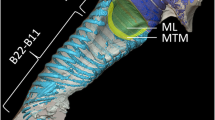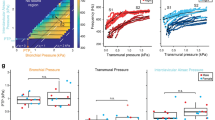Summary
Male canaries (Serinus canaria) produce songs of long duration compared to the normal respiratory cycle. Each phrase in a song contains repetitions of a particular song syllable, with repetition rates for different syllables ranging from 3 to 35 notes/s. We measured tracheal airflow and air sac pressure in order to investigate respiratory dynamics during song.
Song syllables (11–280 ms) are always accompanied by expiratory tracheal airflow. The silent intervals (15–90 ms) between successive syllables are accompanied by inspiration, except for a few phrases where airflow ceases instead of reversing. Thus, the mini-breath respiratory pattern is used most often by the five birds studied and pulsatile expiration is used only occasionally.
Songs and phrases accompanied by minibreaths were of longer duration than those accompanied by pulsatile expiration, presumably because the animal's finite vital capacity is not a limiting factor when the volume of air expired for one note is replaced by inspiration prior to the next. Pulsatile expiration was used for only a few syllable types from one bird that were produced at higher repetition rates than syllables accompanied by mini-breaths. We suggest that male canaries switch to pulsatile expiration only when the syllable repetition rate is too high (greater than about 30 Hz) for them to achieve mini-breaths.
Changes in syringeal configuration that may accompany song are discussed, based on the assumption that changes in the ratio of subsyringeal (air sac) pressure to tracheal flow rate reflect changes in syringeal resistance.
Similar content being viewed by others
References
Barnas GM, Rautenberg W (1987) Temperature control. In: Seller TJ (ed) Bird respiration, vol I. CRC Press, Boca Raton, pp 131–153
Bech C, Johansen K, Nicol S (1988) Gas exchange during high-frequency ventilation in the pigeon (Columba livid). Acta Physiol Scand 132:217–221
Berger M, Hart JS (1968) Ein Beitrag zum Zusammenhang zwischen Stimme und Atmung bei Vögeln. J Ornithol 109:421–424
Bernstein MH, Schmidt-Nielsen K (1974) Ventilation and oxygen extraction in the crow. Respir Physiol 21:393–401
Brackenbury JH (1972) Lung-air-sac anatomy and respiratory pressures in the bird. J Exp Biol 57:543–550
Brackenbury JH (1978a) Respiratory mechanics of sound production in chickens and geese. J Exp Biol 72:229–250
Brackenbury JH (1978b) A comparison of the origin and temporal arrangement of pulsed sounds in the songs of the grasshopper and sedge warblers,Locustella naevia andAcrocephalus schoenobaenus. J Zool 184:187–206
Brackenbury JH (1982) The structural basis of voice production and its relationship to sound characteristics. In: Kroodsma DE, Miller EH (eds) Acoustic communication in birds, vol I. Academic Press, New York, pp 53–73
Calder WA (1970) Respiration during song in the canary (Serinus canaria). Comp Biochem Physiol 32:251–258
Catchpole CK (1982) The evolution of bird sounds in relationc to mating and spacing behavior. In: Kroodsma DE, Miller EH (eds) Acoustic communication in birds, vol I. Academic Press, New York, pp 297–319
Gaunt AS (1987) Phonation. In: Seller TJ (ed) Bird respiration, vol I. CRC Press, Boca Raton, pp 71–94
Gaunt AS, Gaunt SLL (1977) Mechanics of the syrinx inGallus gallus. II. Electromyographic studies of ad libitum vocalizations. J Morphol 152:1–20
Gaunt AS, Gaunt SLL (1985a) Syringeal structure and avian phonation. In: Johnston RF (ed) Current ornithology, vol 2. Plenum Press, New York, pp 213–245
Gaunt AS, Gaunt SLL (1985b) Electromyographic studies of the syrinx in parrots (Aves, Psittacidae). Zoomorphology 105:1–11
Gaunt AS, Stein RC, Gaunt SLL (1973) Pressure and air flow during distress calls of the starling,Sturnus vulgaris (Aves; Passeriformes). J Exp Zool 183:241–262
Gaunt AS, Gaunt SLL, Hector DH (1976) Mechanics of the syrinx inGallus gallus. I. A comparison of pressure events in chickens to those in oscines. Condor 78:208–223
Gaunt AS, Gaunt SLL, Casey RM (1982) Syringeal mechanics reassessed: evidence fromStreptopelia. Auk 99:474–494
McCasland JS (1987) Neuronal control of bird song production. J Neurosci 7:23–39
Nottebohm F, Nottebohm ME (1976) Left hypoglossal dominance in the control of canary and white-crowned sparrow song. J Comp Physiol 108:171–192
Schild D (1986) Syringeale Kippschwingungen und Klangerzeugung beim Feldschwirl (Locustella naevia). J Ornithol 127:331–336
Suthers RA, Hector DH (1982) Mechanism for the production of echolocating clicks by the grey swiftlet,Collocalia spodiopygia. J Comp Physiol 148:457–470
Suthers RA, Hector DH (1985) The physiology of vocalization by the echolocating oilbird,Steatornis caripensis. J Comp Physiol A 156:243–266
Author information
Authors and Affiliations
Rights and permissions
About this article
Cite this article
Hartley, R.S., Suthers, R.A. Airflow and pressure during canary song: direct evidence for mini-breaths. J. Comp. Physiol. 165, 15–26 (1989). https://doi.org/10.1007/BF00613795
Accepted:
Issue Date:
DOI: https://doi.org/10.1007/BF00613795




